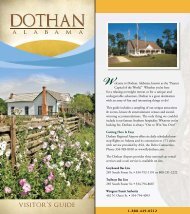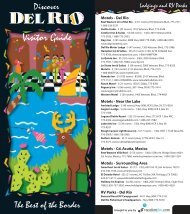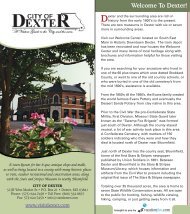PRINT THIS iBROCHURE - VacationFun.com
PRINT THIS iBROCHURE - VacationFun.com
PRINT THIS iBROCHURE - VacationFun.com
Create successful ePaper yourself
Turn your PDF publications into a flip-book with our unique Google optimized e-Paper software.
HISTORY<br />
Our Heritage<br />
In the summer of 1891, Lucien L. Nunn, in<br />
partnership with George Westinghouse and<br />
Nikola Tesla, revolutionized the power industry<br />
with the world’s first successful transmission<br />
of alternating current (AC) power from his<br />
hydroelectric plant in Ames to the Gold King<br />
Mine near Alta. The benefits of inexpensive<br />
power for mining and milling concerns were<br />
immediate and substantial. From 1893 to 1929,<br />
tens of millions of dollars in gold, silver, lead,<br />
copper and zinc ore were extracted from the 350<br />
miles of multi-level tunnels that honey<strong>com</strong>bed<br />
the interior of the mountain basins east of<br />
Telluride. From 1905 to 1911 alone, the Telluride<br />
district turned out over $16,200,000 in gold and<br />
silver: The Liberty Bell, Smuggler-Union and<br />
the Tomboy Mines accounted for 90 percent<br />
of that sum. Slowdowns at the mines followed<br />
WWI, and with the onslaught of the Depression,<br />
mining in Telluride came to a virtual standstill.<br />
Despite a brief reprisal in the ’50s and ’60s, by<br />
the late 1960s, the population dwindled to less<br />
than 600 residents. Telluride was little more than<br />
a ghost town.<br />
White Gold<br />
In its own magical way, Telluride resurrected<br />
itself during the 1970s, when several of its<br />
more enterprising and forward-looking citizens<br />
recognized that the town’s history and majestic<br />
scenery attracted people and that winter<br />
recreation could provide an alternative to the<br />
unpredictable business of mining. When a small<br />
group of wishful locals, led by Billy Mahoney,<br />
Sr., joined forces with entrepreneur Joe Zoline,<br />
a ski area was literally cut out of the north face<br />
of Gold Hill’s slope down to the south side of<br />
town. During Telluride’s centennial anniversary<br />
in 1978, Telluride Ski Corp. began implementing<br />
a grand expansion plan that would soon place<br />
Telluride and Mountain Village on the map of<br />
world-class resorts, while in the east end of<br />
the valley the mines and mill closed for good.<br />
Telluride’s transformation from mining town to<br />
resort city was <strong>com</strong>plete. Ore buckets gave way<br />
to gondolas.<br />
Cultural Mecca<br />
In 1963, Telluride was recognized by the<br />
secretary of the interior and processed through<br />
the National Park Service as “nationally<br />
significant in American history and culture.”<br />
Because of its nineteenth-century frontier boomtown<br />
façade and Queen Anne-style architecture,<br />
Telluride was designated a National Historic<br />
Landmark District. The turn-of-the-past-century<br />
buildings in Telluride, and mining relics in the<br />
surrounding mountains, preserve the region’s<br />
legacy, and each year thousands of visitors<br />
<strong>com</strong>e to explore its past and enjoy its present.<br />
As alpine enthusiasts shaped Telluride’s<br />
winter scene, artists and culture lovers nurtured<br />
a vibrant and diverse array of summer festivals,<br />
and Telluride was reborn as a year-round resort.<br />
The longest-running events—Telluride Film<br />
Festival, Telluride Bluegrass Festival, Telluride<br />
Chamber Music and the Imogene Pass Run—all<br />
began as small grassroots efforts in the early<br />
’70s. A host of events has since joined the<br />
celebration—including Mountainfilm, Jazz<br />
Celebration, Telluride Blues & Brews Festival,<br />
Wild West Fest, Telluride Balloon Festival,<br />
Telluride Mushroom Festival, Cajun Fest, Plein<br />
Air, Tech Fest, Walking Words, Telluride Music<br />
Fest and Writers in the Sky.<br />
You Are Here<br />
Today, Telluride’s population of 2,200-plus<br />
residents is less than half of what it was during<br />
the mining heyday. Miners have been replaced<br />
by (or have be<strong>com</strong>e) skiers and snowboarders.<br />
Festivals have grown up and enhanced their<br />
offerings, but Telluride’s history is not forgotten.<br />
Look around: Whether you stumble across<br />
an old mining shack in the forest or scale a<br />
rugged peak for a majestic view, you’ll find that<br />
Telluride’s mountains are still full of riches, and<br />
the spirit of the Old West remains.<br />
Telluride Historical Museum<br />
On the National Register of Historic Places,<br />
Telluride Historical Museum was built in 1896<br />
by Dr. H.C. Hall as the miners’ hospital. Located<br />
at the north end of Fir Street, it served as an<br />
infirmary until 1964 and reopened as a museum<br />
in 1966. After finding in 1994 that the stone<br />
building was on the verge of collapse, it was<br />
stabilized, restored and reopened seven years<br />
later with new displays. The eclectic collection<br />
is three dimensional with staged groupings<br />
and hands-on interactive features, including a<br />
hospital room, a model that shows how Nunn’s<br />
original AC power transmission worked, mining<br />
artifacts, and many historic photographs and<br />
relics from the region. Hours are Tuesday<br />
through Saturday 11 a.m. to 5 p.m. with<br />
extended hours on Thursdays to 7 p.m. Call<br />
970.728.3344 for more information, or visit the<br />
museum online at www.telluridemuseum.org.<br />
Early Withdrawl<br />
During Telluride’s mining heyday,<br />
the town’s fortune and notoriety<br />
attracted all sorts. Robert<br />
Leroy Parker, Tom McCarty<br />
and Matt Warner (and some<br />
say a fourth) were particularly<br />
intent on cashing in on the<br />
town’s growing prosperity when<br />
on June 24, 1889, the gang<br />
“withdrew” close to $24,000<br />
from the San Miguel Valley<br />
Bank. The robbery was the first<br />
of many led by Parker, who<br />
later became famous as Butch<br />
Cassidy. Contrary to popular film<br />
legend, the Sundance Kid didn’t<br />
participate in this heist.<br />
22 Telluride & Mountain Village Visitor Guide summer/fall 2009 Make reservations or get information online at www.VisitTelluride.<strong>com</strong><br />
BOTH IMAGES COURTESY TELLURIDE HISTORICAL SOCIETY





